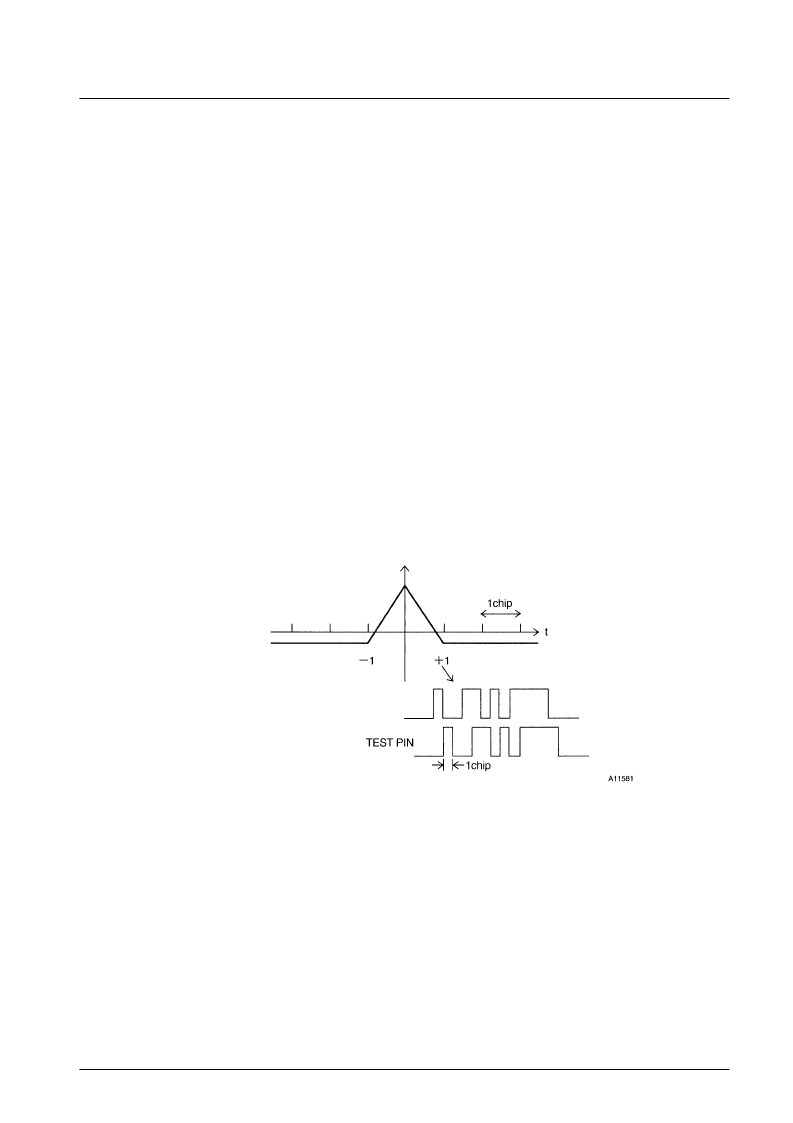- 您現(xiàn)在的位置:買賣IC網(wǎng) > PDF目錄358961 > LV2700V (Sanyo Electric Co.,Ltd.) Spread Spectrum Communications IC(頻譜擴(kuò)展通訊芯片) PDF資料下載
參數(shù)資料
| 型號: | LV2700V |
| 廠商: | Sanyo Electric Co.,Ltd. |
| 英文描述: | Spread Spectrum Communications IC(頻譜擴(kuò)展通訊芯片) |
| 中文描述: | 擴(kuò)頻通信集成電路(頻譜擴(kuò)展通訊芯片) |
| 文件頁數(shù): | 10/20頁 |
| 文件大?。?/td> | 343K |
| 代理商: | LV2700V |

PN Code synchronization
In order to obtain data by demodulating the signal that has been spread spectrum modulated, it is necessary first to
unspread the signal and convert it into a narrow band signal. This unspreading operation is made by multiplying the
input high frequency signal with the PN code in a manner similar to the spreading operation made in the transmitting
side. The PN code used at this time should be the same PN code that was used at the transmitting side. However, it is
not possible to recover the narrow band signal before spreading by merely using the same code. It is necessary for the
phases of the PN codes on the transmitting and receiving sides be matched to within ±1 chip.
Let us consider this from the autocorrelation function. Fig. 4 shows the autocorrelation function of the PN code. Two
identical PN codes are taken, and the autocorrelation function is obtained by evaluating the sum of products with one
code kept fixed as the reference and the other code shifted by one chip at a time relative to the reference code, that is,
each of the chips is multiplied with the corresponding chip at the same position and the sum of the products is obtained.
As shown in the figure, the autocorrelation function is highly characteristic in that it shows meaningful output values
only within a limited range. Therefore, in other words, the correlation value will always be –1 when there is a phase
difference of more than ±1 chip, and the value becomes a maximum when the two PN codes have the same phase.
Consequently, the process of PN synchronization consists of making the phase of the receiving side PN code to the
phase of the transmitting side PN code so that the correlation value between the two transmitting side and receiving
side PN codes becomes a maximum.
In general, the process of establishing PN code synchronization can be considered to consist of the two stages of firstly
the initial process in which the phase of the receiving side PN code is made to be within ±1 chip of the transmitting side
PN code at which the autocorrelation output appears, and thereafter the process of obtaining the best synchronization
point while maintaining the level of synchronization obtained earlier so that the autocorrelation function value becomes
a maximum. The first of these two process stages is called initial acquisition and the second stage process is called
synchronization maintenance and tracking control.
Fig. 4 Autocorrelation function
No. 5651-10/20
LV2700V
Reference PN
Autocorrelation function
相關(guān)PDF資料 |
PDF描述 |
|---|---|
| LV3100M | Parametric Equalizer |
| LV320MH | 32 Megabit (4 M x 8-Bit) MirrorBit⑩ 3.0 Volt-only Uniform Sector Flash Memory with VersatileI/O⑩ Control |
| LV3400M | FM Multiplex Filter(FM多路濾波器) |
| LV3400 | FM Multiplex Filter |
| LV3403M | 3V Operation Filter for FM Multiplex Broadcasting Reception(用于FM多路廣播接收的3V運(yùn)算濾波器) |
相關(guān)代理商/技術(shù)參數(shù) |
參數(shù)描述 |
|---|---|
| LV-271M2G---3035S | 制造商:Surge Components Inc 功能描述:CAP ALUM 270UF 400V ?20% 2000LHRS 30 X 35 - Bulk |
| LV-271M2W---2550S | 制造商:Surge Components Inc 功能描述:CAP ALUM 270UF 450V ?20% 2000LHRS 25 X 50 - Bulk |
| LV-271M2W---3040S | 制造商:Surge Components Inc 功能描述:CAP ALUM 270UF 450V ?20% 2000LHRS 30 X 40 - Bulk |
| LV-271M2W---3535S | 制造商:Surge Components Inc 功能描述:CAP ALUM 270UF 450V ?20% 2000LHRS 35 X 35 - Bulk |
| LV275DI-Q4 | 制造商:Okaya Electric America Inc 功能描述: |
發(fā)布緊急采購,3分鐘左右您將得到回復(fù)。